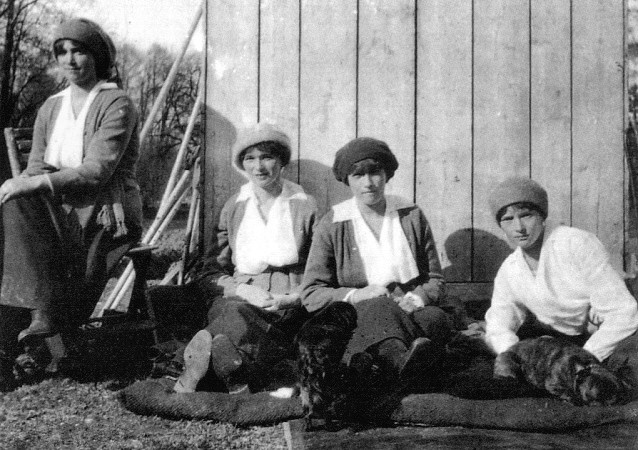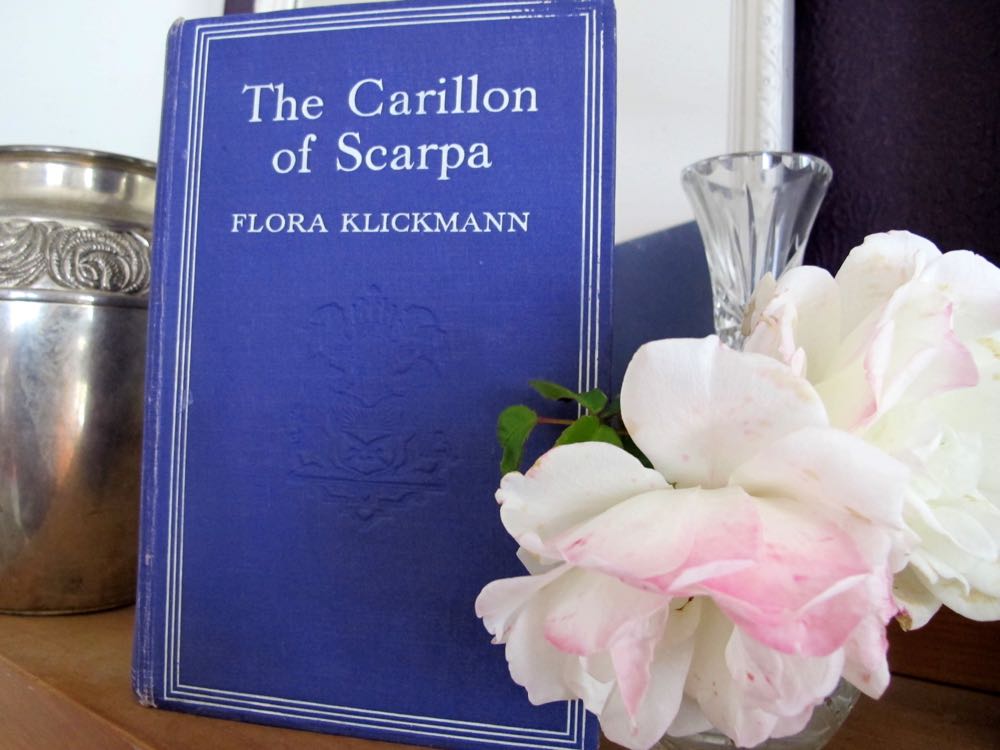I’m a big fan of Flora Klickmann, because her books are such an excellent glimpse into life in England during and shortly after WWI. Her ‘Flower Patch’ collections of autobiographical musings were so popular that she must have run out of personal material, so, in 1925 she decided to try her hand at fiction, in the form of a Ruritanian romance. And thus was born ‘The Carillon of Scarpa’.
I imagine the conversation went something like this:
Editor: So…it’s been a while since you wrote a Flower Patch book. Ready for a new one?
Klickmann: Oh, I don’t know, I don’t really have anything to say there. I was thinking of another handiwork book, or something inspirational on how to be a good person…
Editor: Like the last three? Yeah….those didn’t sell so well. Why don’t you try something different!
Klickmann: Different?
Editor: Yeah, we were thinking you should write a Ruritanian romance.
Klickmann: A Ruritanian romance? With Baltic princesses, swashbuckling men, gypsies, mistaken identities, kidnappings and governments in peril? Ummmm…I write books about flowers and gardening and how religion uplifts the world, with a little bit of humour?
Editor: Yeah, so just write a book about Baltic princesses, swashbuckling men, gypsies, mistaken identities, kidnappings, governments in peril, flowers & gardening, and how religion uplifts the world, with a little bit of humour. Your readers will love it!
And that’s what The Carillon of Scarpa is about, and this reader, at least, loves it.
The princesses in the story are four: Olea, Jessamyne, Myrtle and Mignonette, great granddaughters of Queen Victoria by virtue of their mother and grandmother being English princesses. Their father is Raphael IX of Kingdom of Scarpa, a small country set between Italy and modern Croatia.

Grand Duchesses Maria, Olga, Anastasia and Tatiana Nikolaevna in captivity at Tsarskoe Selo in the spring of 1917
Their similarities in number, name and temperament to another four early 20th century princesses are not coincidental: Klickmann, in her Forward, describes the letters that a princess ‘barely out of her teens’ and ‘one of the victims of the War’ who before the war wrote to her, as the editor of the Woman’s Magazine, about her life and one of her father’s country residences in ‘South-Eastern Europe’. That princess was the inspiration for Olea (who even has Olga as one of her official names, to make it even more obvious).
In true Ruritanian fashion, Scarpa is in trouble: the first line of the novel is “The Throne of Scarpa was tottering!”
In true Klickmann fashion, the heroes of the story are not swashbuckling men, but practical, resourceful women. So the princesses and their intrepid governess (English, natch!) develop an ingenious solution to the problem at hand, and import our second set of heroines: American chicken-roasting heiress Gladsome Potter-Poggs and her social-climbing mother Sally, uh Sarah (What? No? Well, apologies…) Sarella Potter-Poggs.
The women are the centre and the true and obvious heroes of the story – there are the obligatory men to be love interests and villains, but Klickmann struggles to make them more than cardboard cut-outs of desirable husbandly virtues or moustache-twirling slimy awfulness. The women, on the other hand, are wonderful, unique, fully-fleshed out characters. Mrs Potter-Poggs is the most delicious (but sympathetic) send-up of the frantically social-climbing modern women, nerves and all. Garden-mad Gladsome, capable nurse and car driver, is an interesting early depiction of an introvert. Olea is, perhaps, a little too perfect: not surprising as the she is based on a murdered princess, and the tradition of idealising royalty, plus a reluctance to make the dead anything but saint-like, make it practically inevitable. Mignonette runs dangerously close to cute-child-in-media syndrome, but enough of her observations are truly hilarious to excuse the clunkier attempts at making her adorable.
The secondary hero of the story is the scenery: Klickmann devotes as much time to describing the carpets of cyclamen in the Scarpian forests, the pink geraniums cascading over the Palace walls, and the border in violet and blue and grey with touches of yellow that Myrtle is trying out in the Palace gardens, as she does to advancing the plot.
When the plot isn’t grinding to a halt to make you admire the fern-fringed waterfall of Scarpa, it detours to describe the music of the Carillon in detail, or to sing a hymn of praise to religion (Klickmann was, after all, the editor of the most widely-read English-language Christian women’s magazine of her time). Add in space for Klickmann’s social observations (the book would be worth it for them if nothing else), her diversions to solve the ills of the modern world (which range from apt to hilarious – though not for the reasons she may have intended), and her skewering of everything from American press to time-and-efficiency experts (highly amusing), the plot doesn’t advance much.
This is the conversation that I imagine happened when the editor read the first 350 pages:
Editor: What is this!?! You were supposed to be writing a Ruritanian romance?
Klickmann: Well, I did! There is a made-up Eastern European-ish country! There are princesses! And gypsies! There is a romance, the heroine was heroic, and in danger!
Editor: In danger? She singed a few arm hairs! You spent more time describing the chickens in the royal poultry yard! Everyone has behaved sensibly and practically and even the villain behaved well when rebuffed! Add some swashbuckling! Hijackings! A train crash! A kidnapping! Mistaken identities! Life or death situations! Jewel heists! Poisonings! People coming back from the dead! Clever disguises! Someone acting ridiculously! Confessions of undying love and devotion!
So, in the last 150 words, Klickmann managed to add hijackings, train crashes, kidnappings, mistaken identities, life or death situations, jewel heists, poisoning, people coming back from the dead, clever-to-the-point-of-unbelievable disguises, confessions of undying love and devotion, and lots of people acting ridiculously (some exaggeration may occur in that list…or not).
But not too ridiculously, because Klickmann couldn’t bear to make her heroines be totally devoid of sense, so the minute they are given a bit of time to think they try to act as practically as possible, and so pretty much get to save themselves (bless her for this!). So the men have to act as ridiculously as possible to make up for it, and boy, do they ever!
As ridiculous as the men’s actions are the descriptions of love. I swear I did not make this sentence up:
Presently, when it seemed that some new and wonderful link had been forged, uniting soul to soul with a bond that nothing on earth could sever, they began to speak in low tones, with a complete understanding born of their mutual love.
And it goes on like that for three pages!
Not surprisingly in a 1920s novel, some of the content is less-than-admirable by modern standards. Scarpia may be imaginary, but the characterisation of the national temperament is a bit dodgy, considering its how the English so often viewed Southern Europeans. And the content involving gypsies is simply cringe-worthy. So you get to see both the good and the bad of 1920s viewpoints.
The Carillons of Scarpa is both an amusing, and occasionally painful, glimpse into life and attitudes in the years immediately following WWI.




This was so much fun. Thanks for writing!
Some people of my familly temporaly lived in Russia during WWI. They were working there, fighting and one great grandmother was war refugee, flying from Baltic to Siberia. One of them brought backt this photo of tsars daughters: http://i.dailymail.co.uk/i/pix/2014/03/19/article-0-1C6B1F8300000578-240_634x784.jpg
When I was little girl, my parents showed it to me: “Look how real princesses look like.” I adored their beautiful and noble faces, but was rather disapointed by “plain” dresses – no frills, bows and crinolines. Once I asked: “How are they today? Did they married and become queens?” My parents reply: “No, they were shot dead by comunist few years after this photo was taken.” Strange feeling for young child.
Czechoslovak legions? Or previous emigrees? 🙂
(My great-grandfather was a war prisoner in Russia who later came back with the legions. There were no stories of princesses in the family; there was, instead, a story about cooking too much rice and throwing the excess to the wolves, somewhere in Siberia.)
It was mixed – one was working there (but still visiting mother country very often) and enter to Legions as volunteer on very beginning of war, other one was war prisoner and then enter Legions. One of greatgrandmothers moved to there to her godmother after both of her parent died and lived there for few years, other one was Baltic fleeing German army and she joined Legions as a spouse (and later wife) of one soldier.
Thank you Leimomi, you obviously have a fall back vocation as a book reviewer. Keep writing these, I still remember your assessment of Girl of the Limberlost.
Sounds hilarious! I shall have to keep an eye out for Klickmanns. Speaking of novels written by women who write about handiwork, have you ever read “Embroidery Mary” by Priscilla M Warner? It’s one of my favourites – rather sweet, but by no means cloyingly so.
Ahem. You mean the Balkans. Not the Baltics. The Baltics are to the north of Czechia. Croatia is to the south of it, where Balkan is. You can remember it by remembering where the Baltic Sea is, sitting next to Finland and Sweden (and our family favourites, the actual Baltic countries Lithuania, Latvia and Estonia), and very far away from the warm Croatia. 😉
Other than that, hilarious, amusing, and intriguing! One can never have too many sensible heroines.
Sorry, I was making a purposeful joke about the random geography in Ruritanian romances, but obviously not a successful one! 😉
I guess being tuned to that particular mistake aready, I’m not tuned finely enough to realise when it’s a joke!
Adventure, swashbuckling, ridiculousness, practical heroines, gardening – sounds delightful! Who ends up with Ronald Coleman? 😉
Thank you for the review! Have you ever read Barbara Pym? You might enjoy her also.